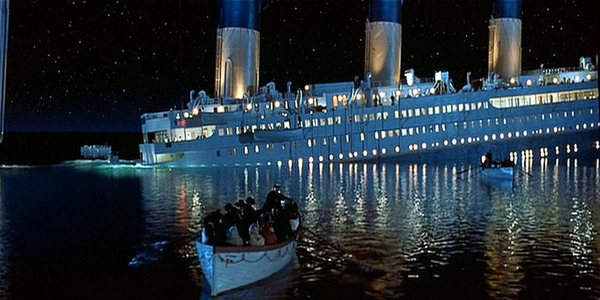Why The Titanic Really Sank, According To A New Documentary

Pretty much everybody knows the story of the unsinkable Titanic and what happened to make it sink back in 1912. Between the scale of the disaster and the 1997 movie that still has people debating whether or not Leonardo DiCaprio could have lived, the sinking of the Titanic is a piece of history that will live on. According to a new documentary, however, the story of the ship sinking because of the way the ship collided with an iceberg isn't entirely accurate. In fact, the documentary argues that an incident that occurred before Titanic set sail is responsible for the ship going down.
In Titanic: The New Evidence, newly-discovered photos of the Titanic before it started on its ill-fated maiden voyage will be used as proof that the structure of the ship was already damaged before it ever encountered any icebergs. The photos come from the previously unreleased private collection of John Kempster, who worked as the chief electrical engineer on the Titanic. The documentary claims that it was a fire in a coal bunker belowdeck that weakened the hull to the point that it didn't stand a chance when it eventually hit the iceberg.
The key pieces of evidence to support the theory of the coal fire weakening the hull are two photos that show a black streak on the side of the ship while it was still in the shipyard. The 30-foot long streak is considered proof that a fire caused damage that could not be repaired without significant cost. Titanic: The New Evidence posits that the owners of the Titanic were aware of the fire and its damage but chose to move forward with the maiden voyage to protect their investments.
The filmmakers make their case for the coal fire by using coloring techniques and CG on the photos, according to EW. If the coal fire really did cause the black streak and weaken the hull of Titanic, history buffs can add one more factor to the list of errors that contributed to one of the greatest catastrophes in maritime history. The ship was built as quickly and cheaply as possible, and human error on the night of the sinking led to an iceberg collision. Throw in the coal fire, and it seems that everything that could have gone wrong did go wrong.
Of course, the Titanic went down more than a century ago, so we may never know the entire truth of what happened on that fateful night in 1912 when the unsinkable ship sank to the bottom of the Atlantic. We can bet that the coal fire theory will be hotly debated for years to come. Personally, I'm just hoping that James Cameron doesn't pull a George Lucas and decide to go back and edit Titanic to include the coal fire.
You can see more of the new theory about the Titanic and make up your mind for yourself when Titanic: The New Evidence hits the airwaves on Saturday, January 21 at 8 p.m. ET on the Smithsonian Channel. Be sure to check out our midseason TV premiere schedule to see what else you can catch on the small screen in the coming weeks.
Your Daily Blend of Entertainment News

Laura turned a lifelong love of television into a valid reason to write and think about TV on a daily basis. She's not a doctor, lawyer, or detective, but watches a lot of them in primetime. CinemaBlend's resident expert and interviewer for One Chicago, the galaxy far, far away, and a variety of other primetime television. Will not time travel and can cite multiple TV shows to explain why. She does, however, want to believe that she can sneak references to The X-Files into daily conversation (and author bios).
